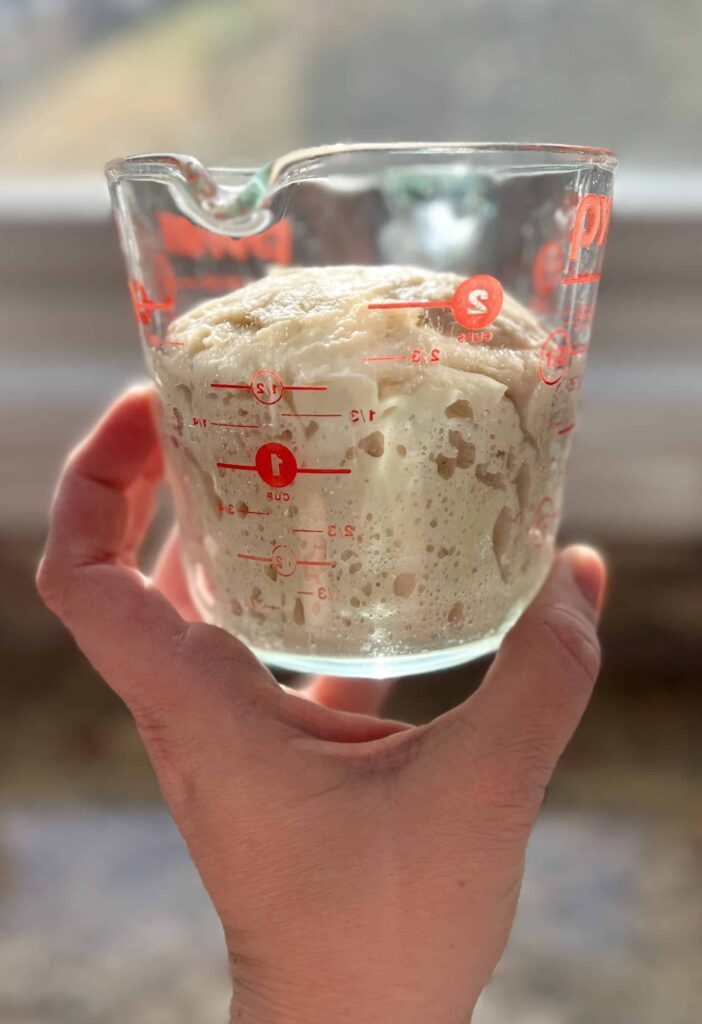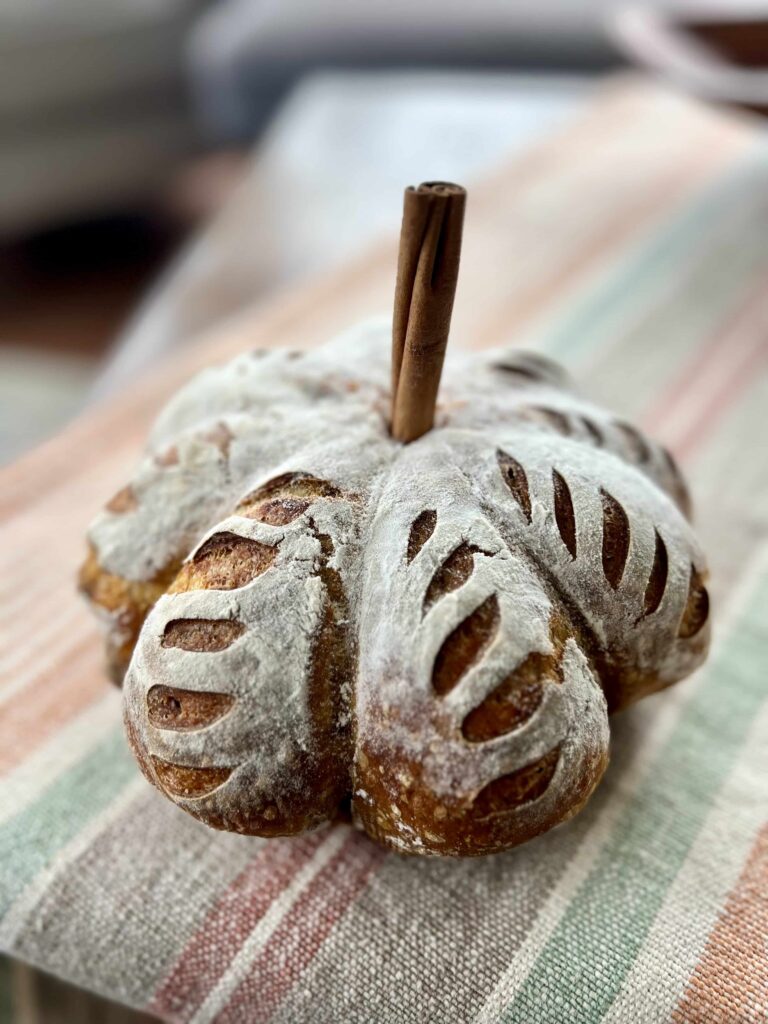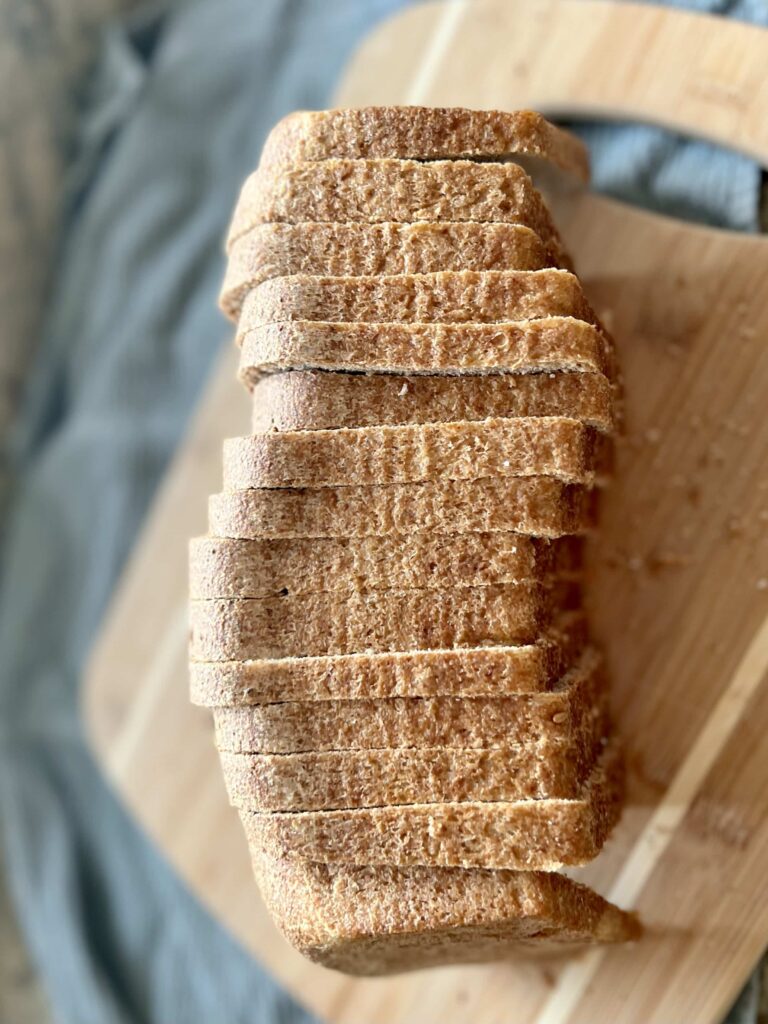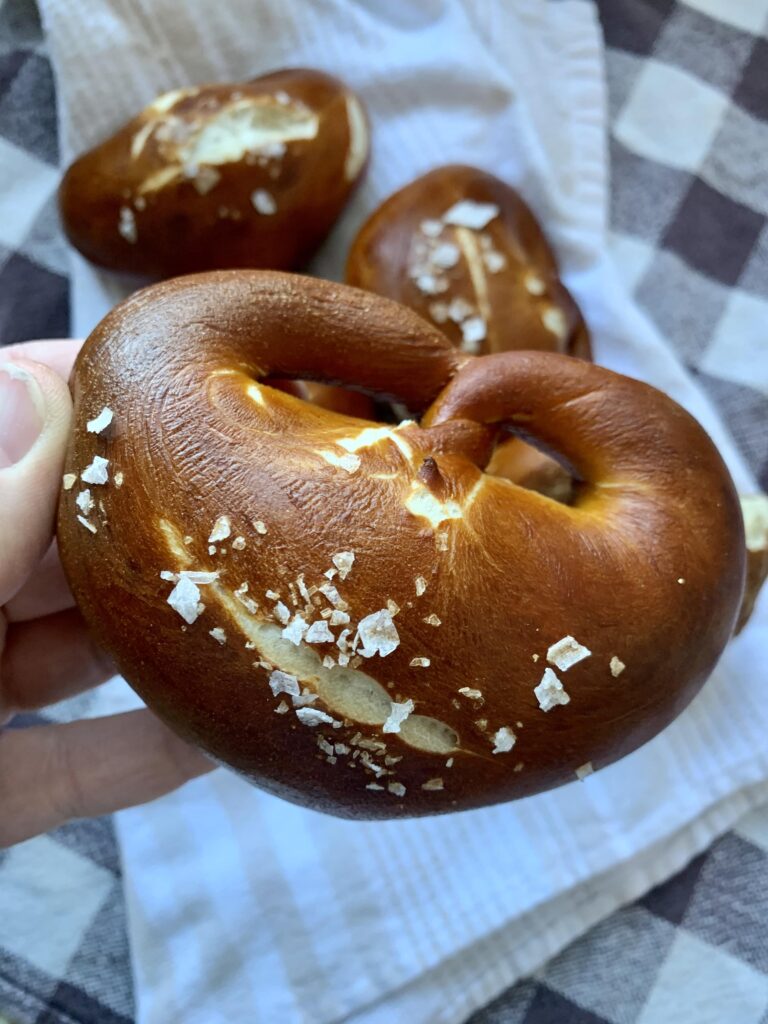Sourdough Blueberry Bagels
This post may contain affiliate links. Please read our disclosure policy.If you love blueberry and you love bagels – this is a combination you need to try! Slightly sweet with delicious blueberry flavor coming through, these sourdough blueberry bagels are made with 100% natural yeast (sourdough) and they are incredibly delicious. Sourdough blueberry bagel dough uses a combination of fresh (or frozen) blueberries and dried blueberries to get that delicious flavor and blueberry color. Toast them or enjoy one fresh and warm with some cream cheese – this is going to be your new go-to blueberry bagel recipe!

Why You’ll Love Sourdough Blueberry Bagels
You will love that this recipe is easy to follow and tastes delicious. This is not a sour-tasting bagel. It’s a sweet blueberry flavor that everyone will love. Keep these bagels in your freezer for easy breakfasts or keep the shaped dough overnight in the fridge and bake them on a special morning. This recipe is adaptable to your schedule. and it’s going to be a big hit with your family and friends. Enjoy!
Sourdough Baker’s Timeline
Bread made with 100% natural yeast takes extra time. Because of this. I like to start my sourdough recipes with a sample schedule so I can get an idea for what the timing looks like. This sample schedule assumes you are using a ripe/active sourdough starter and keeping your dough at a temperature of 78-80ºF.
| Day 1 | Overnight 10-12 hours |
| 8:00 PM – 8:00 AM | Mix Stiff Sweet Levain |
| Day 2 | Mix/Bulk Fermentation/Shape/Proof/Boil & Bake |
| 8:00 AM – 8:15 AM | Mix Bagel Dough |
| 8:15 AM – 12:15 PM | Bulk Fermentation at 78ºF |
| 12:15 PM – 12:30 PM | Shape Bagels |
| 12:30 PM – 4:30 PM | Proof about 4 hours at 80ºF |
| 4:30 PM – 5:00 PM | Boil and Bake |

Important Ingredients in Blueberry Bagels
- Ripe Sourdough Starter: Use an active/ripe sourdough starter (doubled in size/bubbly/mild sour aroma) to mix the levain
- Pure Maple Syrup: I use pure maple syrup for a little sweetness in these blueberry bagels. It pairs so well with the blueberry flavor.
- Bread Flour: I almost always use bread flour for any bread that I am kneading. In this bagel recipe I chose to use only bread flour instead of the high-protein flour I recommend in my sourdough bagel recipe. If you prefer to use a high-protein flour, you can add a little extra vital wheat gluten to the dough to increase the protein content of the flour – but bread flour works great with these blueberry bagels.
- Diastatic Malt Powder: A small amount of this powder helps encourage fermentation, impart flavor and gives a caramelization color to the bagel dough. I like using it in the bagels, but I have made the dough both ways and leaving it out is also okay.
- Water: Room temperature or slightly warm water helps the dough keep a good temperature during fermentation.
- Salt: Salt is important to balance the flavors. Don’t leave it out.
- Fresh Blueberries: Mash the fresh blueberries before adding to the dough. If you prefer using frozen blueberries, thaw them, drain them and then mash them.
- Dried Blueberries: Dried blueberries are also added to the dough after the dough has been mostly kneaded and mixed. They are what give the most blueberry flavor to these sourdough blueberry bagels.
- Cornmeal: This is used for sprinkling on a baking sheet before proofing the bagels and keeps the bagels from sticking to the pan.

How to Make Sourdough Blueberry Bagels
Stiff Sweet Levain
This recipe for sourdough blueberry bagels begins by making a stiff sweet levain. I like using this instead of a sourdough starter because it gives my bagels more height, rise and a little more leeway to when I can boil and bake them. You can read more about levain and why I like using it here. To mix this stiff sweet levain, mix together:
- 10 grams ripe, active sourdough starter
- 10 grams granulated sugar
- 30 grams water
- 60 grams all-purpose or bread flour
This will be thicker than a traditional 100% hydration levain and will require a bit of kneading to incorporate the sourdough starter. Place the freshly kneaded levain into a clear jar and cover lightly. Let it sit at 78°F for about 10-12 hours until levain has doubled in size, is rounded on the top and full of bubbles.


Mixing the Dough
To the the bowl of a stand mixer, add all of the ripe levain. Mash the blueberries until most of the juices have been released. Add mashed blueberries, water, maple syrup, bread flour, salt and diastatic malt powder to the bowl. Start the mixer and knead the dough together for about 8 minutes until smooth. The dough should be smooth, tacky to the touch and not overly sticky. If it is sticky, add a little extra flour. Add the dried blueberries and knead for another 1-2 minutes until completely incorporated. If you don’t have a stand mixer, this dough can be kneaded by hand for about 10-15 minutes until smooth.


Bulk Fermentation
Set the dough in a clear container or bowl. Cover it and put in a warm 78°F place. I use a bread proofer in the winter to help the dough develop at the right temperature. If your dough is colder, bulk fermentation will take longer and if the dough is warmer, the bulk fermentation will happen faster. At the end of about 4 hours, the dough will be more cohesive and strong – though it may not have risen very much. It will feel aerated when ready to shape.


Shaping Sourdough Blueberry Bagels
Dump the dough out onto a clean countertop. Cut into 8 equal pieces, about 125 grams each. Take each piece of dough and roll it into a ball, using your hand in a cup-shape (see video here). Take your finger and press directly into the middle of the ball of dough until it goes all the way through, creating a hole. Use your fingers to widen the center hole, moving the dough around in a circle as you stretch it evenly. Place dough on a baking sheet dusted in cornmeal.





Proofing Sourdough Bagels
Cover the bagels with a kitchen towel or sheet pan cover. Let the bagels rise on the baking sheet for about 4 hours at 80°F. I use a baking mat to keep the temperature consistent. The oven with the light on works too, but it may make the process faster or slower depending on the temperature. After about 4 hours the bagels will be puffed up and risen. They won’t look completely doubled, but you should notice a change in their texture – from dense to light and airy. If you press your finger in on the dough it should leave a little indentation. If they don’t look this way, let them continue rising for another 30 minutes to an hour and check again.
Cold Ferment Option: At this point if you want bagels to be ready the following morning, place the pan of proofed/covered bagels in the refrigerator overnight. In the morning you can proceed with boiling and baking the bagels.


Boiling and Baking Sourdough Bagels
Bagels are boiled before being placed in the oven to bake. This gives them their distinctive chewiness that we all love. But this process tends to go quickly, so I like to prepare a few things before:
- Preheat the oven to 425°F
- Place a pot of water over medium-high heat, filled about half way and bring to a boil
- Line a baking sheet with parchment paper.
- Prepare a cooling rack for the bagels to drip dry and have a slotted spoon handy.
Once the water is boiling, take a bagel and place it in the water. It should float almost immediately – that tells you the bagels are proofed and ready to bake. If your bagel sinks and doesn’t float, don’t boil anymore bagels. Give them longer to proof before proceeding with the baking.
Boil the bagels for 40 seconds on one side. Then flip them over and boil on the other side for 40 seconds. After both sides have boiled, remove the bagel from the water and place on the cooling rack to drip dry. Repeat until all of the bagels have been boiled.
Bake the bagels: Place the boiled bagels on the parchment-lined baking sheet, 8 to a pan. Bake in the pre-heated 425°F oven for about 20-25 minutes. Let bagels cool most of the way before enjoying!




Amy’s Recipe Tip
- Dried blueberries are what give sourdough blueberry bagels their delicious blueberry flavor. Due to the long sourdough fermentation time, the blueberries draw some of the moisture out of the dough and into the dried blueberries resulting in the perfect blueberry bagel flavor. Don’t leave them out!
- If you want more blueberry flavor, add 10-15 grams crushed freeze-dried blueberries to the bagel dough while kneading.
Substitutions
This recipe is specific to blueberries. If you are looking to make other types of bagels, try this recipe.
- Maple syrup: I love the subtle sweetness pure maple syrup brings to these bagels but you can also substitute honey or sugar.
- Fresh Blueberries: Substitute fresh blueberries with frozen blueberries. If you choose to use frozen berries, thaw them and drain the liquid from the thawed berries. Then mash the frozen berries and add to the dough. You may need to add a little extra flour to the dough during mixing to compensate for the frozen berries.
- Bread Flour: If you don’t have bread flour, you can substitute all-purpose flour with 10 grams of vital wheat gluten.


How to Store Leftover Sourdough Blueberry Bagels
After the bagels have cooled completely, place them in an airtight container or ziplock bag. Leave on the counter for up to 24 hours or freeze for best results. Thaw, slice and toast when you’re ready to eat.
If you liked this, you’ll also like…
Frequently Asked Questions
To get a deeper purple color you have 2 options:
1. Simmer fresh or frozen blueberries over medium-low heat until reduced a little and thickened. Let the blueberries cool to room temperature before adding to the bagel dough.
2. Add some crushed freeze-dried blueberries to the dough (10-20 grams) for more purple color and extra blueberry flavor.
This doesn’t work very well because of the moisture content in the blueberries. In making this recipe, I tested it a few times and found that using a combination of fresh and dried blueberries with a little extra maple syrup resulted in the perfect blueberry flavor for a bagel. If you want even more blueberry flavor – add some crushed, freeze-dried blueberries to the dough.

Sourdough Blueberry Bagels
Equipment
- Stand Mixer for kneading dough – can also be mixed by hand
- Pot for boiling water
- slotted spoon
Ingredients
Stiff Sweet Levain
- 10 grams sourdough starter ripe, bubbly, active
- 10 grams granulated sugar
- 30 grams water
- 60 grams all-purpose or bread flour
Sourdough Blueberry Bagels
- 100 grams stiff sweet levain ripe, active, peaked, all of it, see recipe notes
- 150 grams fresh blueberries mashed, see recipe notes for frozen
- 150 grams water room temperature
- 40 grams maple syrup see recipe notes
- 475 grams bread flour
- 10 grams salt
- 4 grams diastatic malt powder see recipe notes
- 70 grams dried blueberries reserved for after the dough is mostly kneaded
- cornmeal for sprinkling
Instructions
Day 1: Make Levain (10-12 hours/overnight at 78ºF)
- Stiff Sweet Levain: Mix together ripe, 100% hydration sourdough starter with granulated sugar, water and all-purpose flour. This will be thicker than a traditional 100% hydration levain and will require a bit of kneading to incorporate the sourdough starter. Place the freshly kneaded levain into a clear jar and cover lightly. Let it sit at 78ºF for about 10-12 hours until levain has doubled in size, is rounded on the top and full of bubbles.
Day 2: Mix/Bulk Fermentation/Shape/Proof/Boil/Bake
- Mix the Dough (15 minutes): Set the bowl of a stand mixer on a kitchen scale. Mash the blueberries until most of the juices have been released. Add ripe levain, mashed blueberries, water, maple syrup, bread flour, salt and diastatic malt powder to the bowl. Start the mixer and knead the dough together for about 8 minutes until smooth. The dough should be smooth, tacky to the touch and not overly sticky. If it is sticky, add a little extra flour to the dough. Add the dried blueberries and knead for another 1-2 minutes until completely incorporated. This dough can also be kneaded by hand for about 10-15 minutes until smooth.
- Bulk Fermentation (4 hours): Move the dough to a container. Do your best to keep the temperature of the dough at 78ºF. I use a bread proofer in the winter to help the dough develop at the right temperature. Cover the container. The entire bulk fermentation will take about 4 hours. At the end of 4 hours, the dough will be more cohesive and strong, although it may not have risen very much. If your dough is colder, this process will take longer.
- Prepare a baking sheet: Sprinkle cornmeal liberally over the sheet. This keeps the bagels from sticking to the pan while they rise.
- Shape Bagels (10 minutes): Separate the dough into 8 equal pieces, about 125 grams each. Take each piece of dough and pull/pinch up the sides until it forms a ball. Roll the ball on the counter using your hand in a cupping shape (see video here) to seal the balls and create tension. Let the balls rest for a minute on the countertop before shaping into bagels. Take your finger and press it directly into the center of the ball of dough until it goes through to the other side, creating a hole. Use your fingers to widen the center hole, moving the dough around in a circle as you stretch it. Let the dough relax and repeat with the next bagel. After you've put holes in all the bagels, stretch them out again as desired and place on the cornmeal-dusted baking sheet.
- Proof Bagels (4 hours): Cover the bagels with a kitchen towel or sheet pan cover and let the bagels rise on the baking sheet for about 4 hours at 80ºF. I use a baking mat to keep the temperature consistent (the oven the with light on works too, but it may make the process faster or slower depending on the temperature). After about 4 hours the bagels will be puffed up and risen. They won't look completely doubled, but you should notice a change in their texture – from dense to light and airy. If you press your finger in on the dough it should leave a little indentation. If they don't look this way, let them continue rising for another 30 minutes to an hour and check again. At this point you can refrigerate the bagels overnight if you prefer to boil and bake them in the morning.
- Prepare Oven and Baking Sheet: Pre-heat the oven to 425ºF. Line a baking sheet with parchment paper.
- Boiling: Place a large pot of water, about half full, on the stove and turn the heat to high. Have a slotted spoon and a cooling rack ready. As soon as the water comes to a boil, place a bagel into the water. It should float within the first 10 seconds or so of placing in the water. If it doesn't, this is a sign of being under-proved. Allow the rest of the bagels to proof and rise a little bit longer. Add as many bagels to the pot of water as you can without stacking bagels on top of each other (they should each have a little personal space in the water). Boil for about 40 seconds and then flip. Boil for 40 seconds on the other side. Using the slotted spoon, remove the bagels from the boiling water and place on the cooling rack to drip dry for a minute before placing on the baking sheet.
- Baking: Bake for 20 – 25 minutes until bagels are golden and baked all the way through. If your bagels are too dark on the bottom, place a baking stone or baking sheet on the rack underneath the bagels to help.
- Cooling: Let bagels cool for about 20-25 minutes before serving. Bagels can be stored for 24 hours at room temperature and then frozen. Enjoy!







I just made your blueberry bagels. It was my first time using a levain. Everything was rising beautifully like it was supposed to. However, after boiling for 40 seconds on each side they deflated. Baking didn’t change anything. Help! They taste fine.
It sounds like they overproofed a little bit. If your dough was warmer or if it was left out a little bit too long then it will still work and they will taste good, but they can deflate a little. Try boiling them a little bit earlier next time.